How Do You Ground a Light Switch without a Ground Wire?
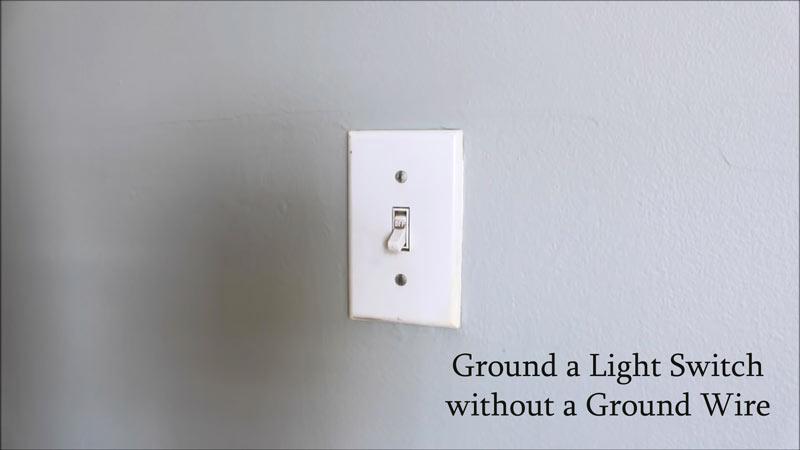
If your box lacks a ground wire, you cannot ground the switch; instead, replace it with a non-conductive faceplate or use a GFCI-protected circuit to ensure safety.
Ensure all wires are neatly folded into the box to prevent damage during installation. If you are having trouble locating an electrical junction box or if you need help finding wires in general, don’t hesitate to contact an expert for assistance.
You'll Learn About
Ground a Light Switch
A lot of people think that they don’t need to ground a light switch, but this is not always the case. Grounding a light switch helps protect against electric shock and can improve the efficiency of your home’s wiring.
The Ground is not Required While Replacing Switch
If the metal box is grounded, the switch may be grounded via the device yoke and mounting screws if it is self-grounding. Otherwise, a ground wire is required.
The Ground is Required During Installation
When installing a switch, it will be grounded via the device yoke and mounting screws. Ensure the ground connection is tight. Loop the wire clockwise around the screw. If you are using the included mounting screws, tighten the screw securely with a screwdriver.
Ground a Light Switch without a Ground Wire
When you’re setting up your new home, one of the first things you’ll need to do is connect ground wires to all switches. This ensures a safe path for fault current.
Tools You’ll Need
- Flat-Head Screwdriver.
- Phillips-Head Screwdriver.
- Needle-Nose Pliers.
- Wire Strippers.
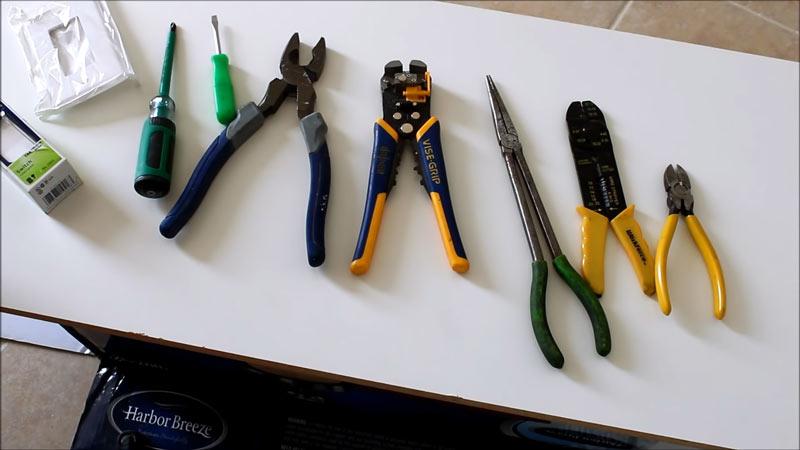
Place a wire connector over the end
A wire connector is a small, round metal device that you can use to connect two wires together. If you are connecting a pigtail, use a wire nut to join it to the circuit ground wire securely.
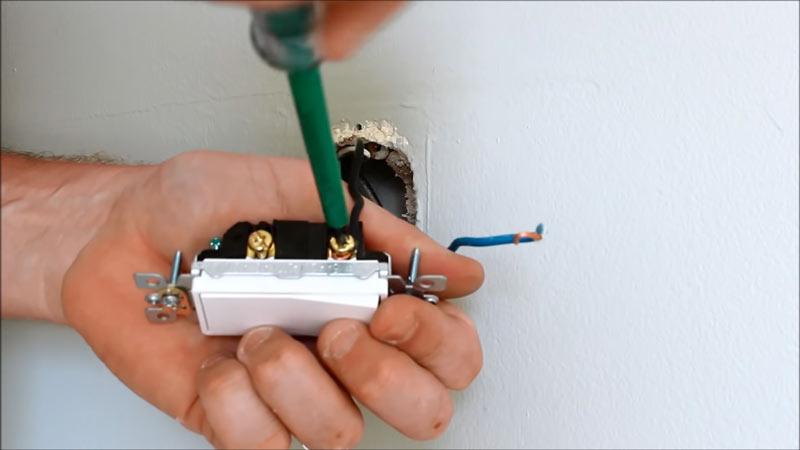
Coil up the ground wire
When grounding your light switch, it’s important to neatly fold the wires into the back of the box. This ensures there is enough room for the switch.
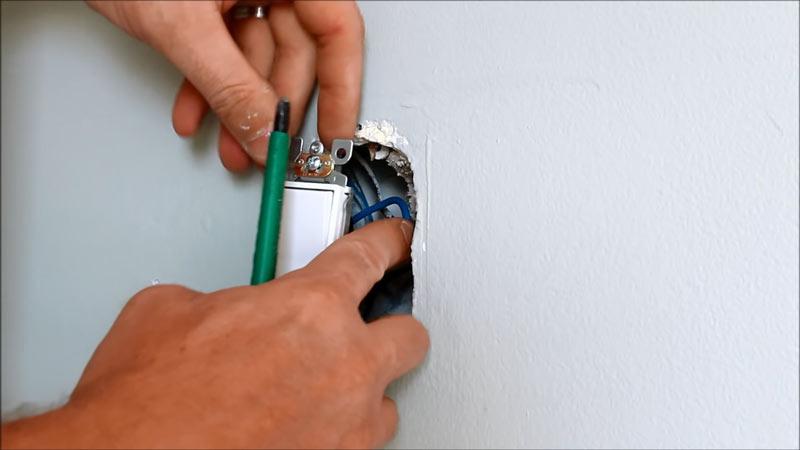
Push it back into electrical junction box
Once you’ve coiled up the ground wire and put the connector over the right end of it, you’ll need to push the necessary ground wire back into the junction box on the room interior wall of the house. Secure the connections and push the wires back into the junction box. Tighten the device mounting screws.
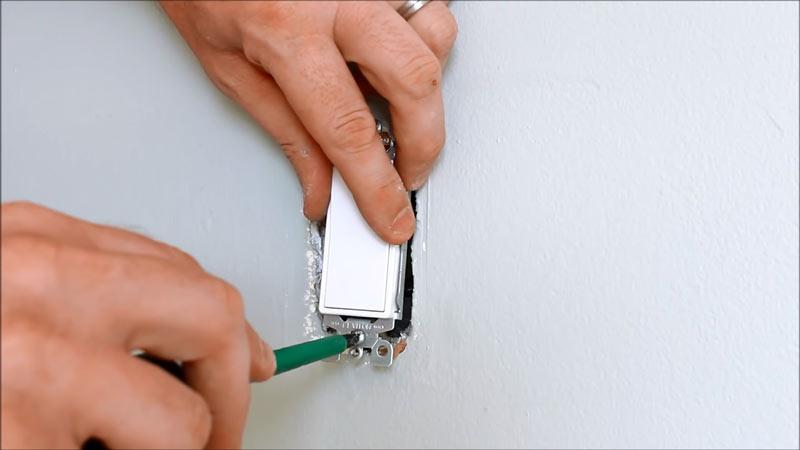
What if my light switch does not have a ground wire?
If your light switch does not have a ground wire, you should protect the circuit with a GFCI breaker or upstream GFCI receptacle. However, some fixtures do not require grounding if they are non-metallic. Like, you can easily install light fixture without a ground wire.
To check if your lights have a ground wire connected, turn off power, remove the switch plate, and inspect the wiring inside the box to see if a ground wire (bare copper or green) is present.
If you do not have any grounded plugs nearby, you can consult a licensed electrician to upgrade your wiring. Finally, always replace an outdated light switch with one that has been wired properly for safety purposes.
Hook up the light without a ground wire
To hook up light without a ground wire, you will need to find the ground wire first. You can install a GFCI device to provide protection on ungrounded circuits.
Verify power is off with a tester before touching any wires.
Attach the ground wire to the mounting screw
You can attach a ground wire to the mounting screw of your light if you want to make sure it is safe and secure. This will help reduce the chances of your light getting damaged in an accident. Let’s see why:
Always Attach Ground Wire
It is always important to attach a ground wire to the mounting screw of your metal electrical box. This will ensure that you have a secure connection to the grounding system. You can also connect this wire to the circuit grounding conductor.
Metal Frame Can Ground Itself
Due to the fact that metal frames are conductive, grounded metal boxes can ground the switch via the mounting screws if the switch is self-grounding. In cases like this, you may not need to attach any extra wires or devices.
Use a Pigtail Off The Box
If you’re using an incandescent light bulb and want it to be grounded, make sure that the connect a ground pigtail from the grounded metal box to the switch’s green ground screw. Then run supply wiring from there down through the conduit to complete the circuit.
Finally, secure the switch in the box and attach the faceplate.
Adding a ground to the knob and tube wiring
No, you shouldn’t add ground to the knob and tube wiring. If there is no ground, a grounded outlet is dangerous there. Let’s discuss it briefly:
No Actual Ground Path Available
If you want to add a ground wire to your knob and tube wiring, you will not be able to do so. This is because knob and tube wiring creates no ground path; adding a wire to nowhere provides no safety.
Knob and Tube Wiring Lacks Grounding Point
Your knob and tube wiring does not have an actual grounding point, which means that adding a ground wire would actually create more problems than it would solve.
There is no grounding conductor in this wiring method.
No Guarantee of Adequate Pathway
Do not attempt to extend a ground from knob and tube wiring. Old wiring insulation may be brittle; consult an electrician before modifying.
Grounding is not Necessary For Everything
Grounding is essential for safety; consult an electrician for rewiring options.
Can a ground wire be added later?
Retrofitting a ground wire can help reduce the risk of electrical problems. But many old houses lack it. This is especially important if you have a newer, more sophisticated home that is equipped with electronics like smart systems and temperature control.
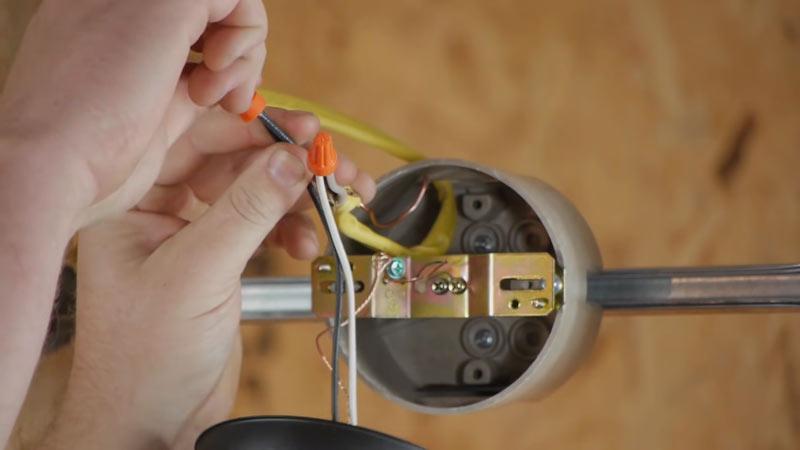
By grounding these components to the electrical systems, you ensure that any fault currents will be eliminated.
Grounding Wire
Ground wires are a traditional safety feature and can help reduce the risk of electric shock. They carry earth-ground potential which helps to stabilize electrical systems and by running them between all your boxes, you’ll create a cleaner look and easier installation process.
Proper Installation of Ground Wire
The proper installation of ground wires is essential for providing protection from accidental shocks. If these wires are not properly installed, they may not provide adequate protection against electric hazards.
It is important that grounds are connected together properly so that there is a clear path for fault current, allowing the breaker to trip immediately during a short.
Ground Wire Location
Properly installing ground wires requires expertise and experience – do not attempt to install them yourself if you aren’t confident in your abilities. A correctly installed ground wire should be connected to the green ground screw on the device and the grounding conductor in the box.
To Recap
Handling ungrounded switches requires care. But you need the right tools with you. The ground wire is the most important part of a light switch. It’s what keeps your lights from getting shocked by a stray current. Some switches have a ground wire already in them, but others don’t.
It’s always a good idea to have a ground wire handy, though. It is important to ground the switch if a wire is available.
Frequently Asked Questions
What is the difference between a plastic switch and a metal switch?
Standard plastic switches are safe, durable, and rated for permanent installation. They are usually mounted on a metal box with screws, and are usually the cheapest option.
Can I Connect the Green Wire to the White Wire?
No, you can’t connect green wire to white wire. No, never connect the green ground wire to the white neutral wire; this is a code violation and a shock hazard.
What if I am installing a plastic switch instead of a metal one?
Standard plastic switches are rated for normal household use and are perfectly safe.
Do I have to put a ground wire in a metal box?
If you have a metal box, you do not need to attach a ground wire to it. If the metal box is grounded, you can use a self-grounding switch or a pigtail. Consult a licensed electrician if unsure.

